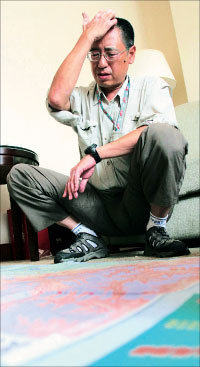Soon after the May 12 quake, the Ministry of Housing and Urban-Rural Development assembled three expert teams to prepare reconstruction plans.
|
 Yin Zhi, director of Tsinghua University's urban planning and design institute, recounts the hazards threatening Wenchuan residents.
Yin Zhi, director of Tsinghua University's urban planning and design institute, recounts the hazards threatening Wenchuan residents. |
Yin Zhi, director of Tsinghua University's urban planning and design institute, was invited to lead a team to work on a plan for the Aba Tibetan and Qiang ethnic autonomous prefecture, one of the worst hit regions.
Arriving in Chengdu on May 18, Yin and his team spent more than 20 days trekking in Aba's high mountains and narrow valleys. In that time, they visited all of its towns and villages, including some that were accessible only by foot and still suffering from landslides, sandstorms and mudslides.
Yin is considered one of the strongest advocates for a major relocation of Wenchuan's residents. After his trip, he sat down with China Daily reporter Wang Xu to discuss his opinions on the issue.
Why do you think it is necessary to relocate Wenchuan's residents?
First of all, it's due to the geological situation. After the earthquake, three fault lines were found beneath the town of Wenchuan, which makes the area highly vulnerable to future tremors. According to existing urban planning regulations, new buildings should keep a certain "safety distance" from such geological hazards. Although there is no compulsory requirement, most experts agree 500-1,000 m is the proper distance. After we take out the unsafe areas near the fault lines, the town could support only 3,000-5,000 people.
Some experts have said there are places where a safety distance of 50 m is enough. But they are individual cases, which would require thorough surveys, and that is unrealistic for Wenchuan, given the time pressures we face.
Moreover, the earthquake has destroyed almost half of the farmland in Wenchuan. If we don't relocate a certain number of people, how will they survive?
Are there any other threats?
Secondary disasters triggered by the earthquake are another concern. Before the earthquake, there were about 160 hazardous spots in Wenchuan; that number is now more than 3,000. These could cause serious secondary disasters such as landslides, mudslides and so on, which are a constant threat to local people. Geologists say it would take eight to 10 years for such disasters to subside. There is also the ever-present threat of sandstorms.
In other words, the earthquake is only the beginning of natural disasters, not the end.
Some experts have said we should not be so quick to give up Wenchuan's thousands of years of history, which some people gave their lives for. What do you think of that view?
Experts who think that should study Wenchuan's history more carefully. Wenchuan's population has grown very rapidly in recent years.
In the 1950s, for example, the county seat of Wenchuan was home to just a handful of families, but now it has more than 40,000 residents. Many of the buildings were built on geologically unsafe land such as former riverbeds.
Also, I am not suggesting we should desert Wenchuan, I am just advising that we relocate those threatened by natural hazards.
Do you think it will be a problem to create new jobs for the people who are relocated? What measures would the government take to help them adapt to a new environment?
There are already some good proposals. Guangdong province, which is expected to help with Aba's reconstruction, is considering an "education relocation" plan, which will offer free vocational education opportunities to junior and senior middle school graduates from Aba.
Under that plan, students from Aba who fail to get into college, would get free training in Guangdong. After their graduation, the provincial government would help them find jobs in the province. After working for a few years, they will be allowed to apply to become permanent residents.
This plan would increase the competitiveness of the young people from Aba, as well as helping solve the labor shortage in the Pearl River Delta region.
Also, once the students have settled down, they could get their parents and other family members to move to Guangdong. The plan, if carried out for a decade or so, could really help with the relocation process.
(China Daily July 16, 2008)